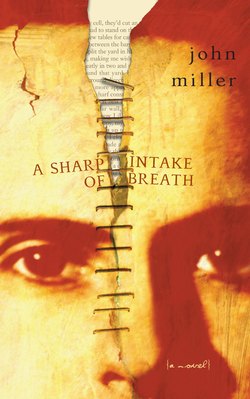Читать книгу A Sharp Intake of Breath - Джон Миллер - Страница 5
На сайте Литреса книга снята с продажи.
acknowledgements
ОглавлениеIt has been said many times that all novelists are thieves. And, since this novel deals in part with guilt and confession, I must get something off my chest: While doing my research, I discovered early life experiences of two late friends of my grandparents, and found their stories to be irresistible. One friend, a jovial, respectable old man I had known at my grand-mother’s Passover table, spent ten years in Kingston Penitentiary in the 1930s for a mistake made as an eighteen-year-old boy. Another, shy, quiet Molly Ackerman, a talented textile artist, was Emma Goldman’s secretary in the 1930s, when Goldman lived in Toronto. Molly is mentioned briefly in Living My Life, and a letter to her from Goldman can be found in the Berkeley archives. (Thanks also to Molly’s daughter Nancy Ackerman for sharing her memories.)
I was lucky to interview the following people whose recollections of Toronto in the 1930s contributed to important contextual material: retired labour organizer Ernie Arnold; retired accountant Albert Friedman; Warren and Joyce Soloman; labour activist and former comrade of Emma Goldman’s, Marie Tiboldo; and dear family friends Dorothy and Harry Stone and Edith Pike.
Paula Klaiman, speech/language pathologist, and Dr. Bill Lindsay, retired cleft lip and palate surgeon, both from the Hospital for Sick Children in Toronto, helped provide valuable knowledge on the surgical procedures and speech therapy used with cleft lip and palate children in Toronto in the 1920s. Dr. Coleman Romalis of York University helped provide insight into Goldman’s Toronto years.
For assistance with research into Emma Goldman’s and Sidonie Colette’s lives in the South of France, many thanks go to the following residents of St-Tropez: Marius Astézan, the town’s cépoun; Laurent Pavlidis and Simone Carrat of the Heritage Society; Marie-Ange Raboutet, town archivist; David Singleton of the Tourism Board; the notaries in the firm of Maître Bortolotti and Maître Malafosse-Bortolotti. It must be emphasized that although my research did in fact lead to the discovery of the location of Bon Esprit, the reader should not presume that the Tropéziens depicted in this novel are in fact the individuals mentioned above. And, although there is no evidence that Goldman and Colette ever met while living in St-Tropez during the same period, the passion with which the Tropéziens spoke of Colette was infectious. I couldn’t resist imagining how such a meeting might have transpired.
I also owe thanks to social worker Ruth Goodman for her insight into geriatrics and life at Baycrest Centre for Geriatric Care and The Terrace, and to Bob Kellermann for his advice on the Canadian legal system.
For detailed critical feedback on early and later drafts, I’m indebted to my mother, Ruth Miller (wordsmith extraordinaire), to my agent Beverley Slopen, to my editor Barry Jowett, and especially to talented novelists Elizabeth Ruth and Sally Cooper, with whom I’ve had the privilege of being in a writing group these past four years. For their general support, I thank the rest of my family—my father, Eric, Tony, Daniel, Joanne, Michele, and Donna—and many friends and colleagues. For specific input and encouragement, I thank Patty Barclay, Craig Mills, Pam Shime, Hilary Trapp, and Dubravka Zarkov. Most of all, I’m grateful for the unwavering encouragement and counsel of my dear friends Vanessa Russell and Debra Shime. Thanks also to copy editor Jennifer Gallant and designer Alison Carr.
Bibliographic and video sources used include the Hon. Mr. Justice Joseph Archambault’s 1938 Report of the Royal Commission to Investigate the Penal System of Canada; Baycrest Terrace Memoirs Group’s From Our Lives; CBC Television’s special program Inside Canada’s Prisons; Jean Cochrane’s Kensington; Colette’s Break of Day; numerous letters from the University of California, Berkeley’s Emma Goldman Archives (Candace Falk, editor); Ruth Frager’s Sweatshop Strife; Jules Henry’s On Sham, Vulnerability & Other Forms of Self-Destruction; Kyle Joliffe’s Penitentiary Medical Services 1835-1983; Alix Kates Shulman’s Red Emma Speaks; John Kidman’s The Canadian Prison: The Story of a Tragedy; Paula Klaiman et al’s video Step by Step: Speech Therapy Techniques for Cleft Palate Speech; Emma Goldman’s Living My Life and Anarchism & Other Essays; Compton Mackenzie’s On Moral Courage; Albert Meltzer’s Anarchism: Arguments For & Against; Ken Moffat’s A Poetics of Social Work; Teresa & Albert Moritz’s The Most Dangerous Woman in the World: A New Biography of Emma Goldman; Thomas Nisters’s Aristotle on Courage; Erna Paris’s Jews: An Account of Their Experience in Canada; Stanley J. Rachman’s Fear and Courage; Coleman Romalis’s video The Anarchist Guest; John Sebert’s The “Nabes”: Toronto’s Wonderful Neighbourhood Movie Houses; Stephen A. Speisman’s Jews in Toronto; Stephen Tudor’s Compassion and Remorse: Acknowledging the Suffering of Others; and Douglas Walton’s Courage: A Philosophical Investigation.
